
Let’s say you’re invited to a dinner party in a few weeks, and you want to bring the host a nice bottle of wine. You normally drink white, but the host drinks red.
What do you do? Instead of looking through the wine rack trying to find the right bottle, you reach out to a friend who you know drinks red.
Thankfully, your friend has the perfect recommendation from a brand they purchase from online… but they also have a surprise: a 10% off discount for your first order.
Because you trust your friend, you make that purchase, and your friend gets 10% off their next order in return. You bring the bottle to the party, the host loves it, and they want to know where you got it. You refer them to it with the same incentive bonus, earning you another discount.
Do you see where I’m going here?
When you think about customer acquisition channels, your mind probably wanders toward strategies like SEO, paid advertising, and influencer marketing. But there’s a missing piece to the puzzle that multiplies the effectiveness of all your acquisition efforts: referral marketing.
Until now, paid advertising channels have been the primary acquisition source for brands, but the new iOS and third-party cookie changes are making this harder. In fact, in the second quarter of 2021 social media ad prices increased 14%, according to Barron’s.
With referral marketing being a tactic that relies on direct recommendations from trusted shoppers, it’s one of the strongest acquisition tools that result in a high return on investment.
To see the best results, referral marketing needs planning and dedication from your entire team. From the marketing department to product, and even customer support, your program’s success all comes down to the right planning and promotion.
In this article, I’ll dive into all of those best practices and more. Just keep reading, or use the jump links to skip to any section!
Referral marketing is a strategy used to encourage a brand’s customers to organically recommend products to family and friends, usually through an incentive like 10% off for both the referrer and referred friend.
The goal? To acquire new shoppers and track customer advocacy.
Here’s a fun graphic below that breaks down how referral marketing works.
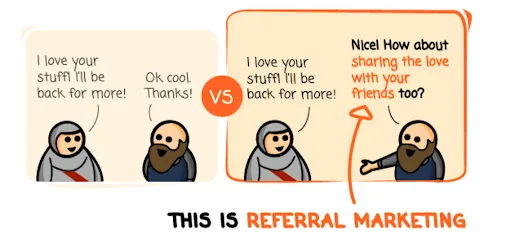
And truthfully, creating a referral strategy is worth it: not only are referred customers four times more likely to refer others to a business they’ve purchased from, but there are several other benefits.
Aside from the fact that motivating your customers to refer their network to your brand is a low-cost way to fuel customer acquisition (duh), there are also five additional referral marketing benefits I think are worth mentioning.
Need more proof? No problem. Here’s an infographic explaining more referral marketing benefits:
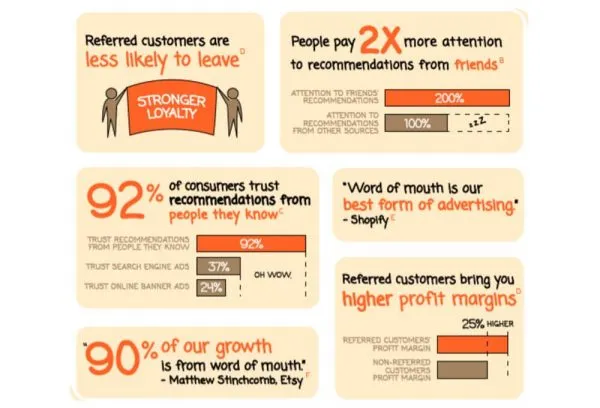
With most food and drink brands selling lower cost and more frequently purchased goods, referral marketing plays a key part in acquisition and creating repeat purchases.
One example is Olipop, a drink brand that offers a $5 credit to both the referrer and referred friend in their program.
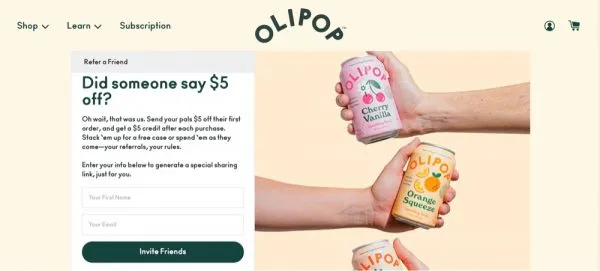
Beauty and cosmetics brands are known for creating hyper-loyal customers. But for beauty brands looking to acquire new customers, getting someone to switch their existing beauty product for a new one is tough.
This is why a referral program is beneficial to the beauty and cosmetic vertical—a trusted recommendation with the added bonus of an incentive is a great way to get a shopper to try a product or two. (And then fall in love and keep purchasing again and again, right?)
Check out Savor Beauty, which offers $25 off to both the referrer and referred friend.
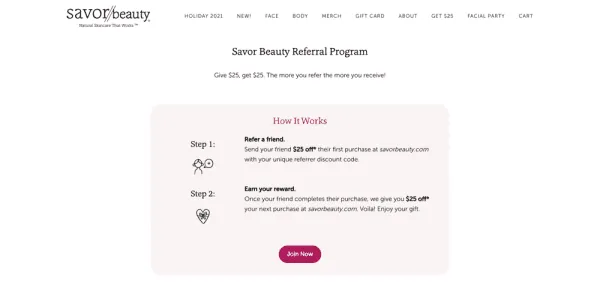
Referral programs are often successful for health and wellness products because fitness communities are a natural network for shoppers to give and ask for referrals. Local gyms or fitness programs give users a built-in community where information is easily shared (think Peloton, for example).
To see a successful referral program in the health vertical, take notes from Transparent Labs: a protein and health supplements brand.
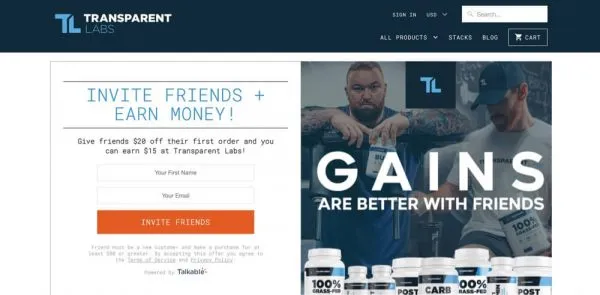
Fashion and apparel brands are notorious for relying on paid advertising for acquisition, but this vertical also sees a lot of success with referral marketing.
One women’s fashion and apparel brand, Dia & Co, created a “give $25 off your first purchase, get $25 off your next purchase” program to encourage referrals. The program is also promoted clearly with a nice-looking banner on the site, so customers can easily discover the perks of participating.
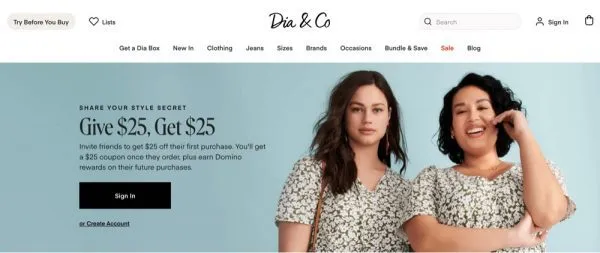
Since consumer electronics may have a higher average order value, in line with production (including, for example, component parts sourcing) and therefore retail costsone successful strategy is to create a referral program that includes a spending minimum.
Satechi’s program is a great example, encouraging members to refer friends and earn a $10 credit after their friend’s first $75+ purchase.
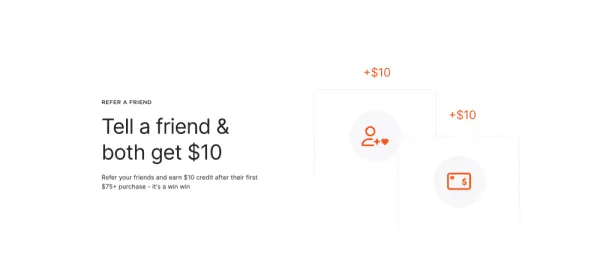
Similar to consumer electronics, home goods brands often have higher-priced products that are purchased less frequently. Since such products are more expensive, people who are actively searching for furniture or decorative items tend to ask their family or friends for recommendations.
So, make it easy for customers to make that referral. This is how CB2 does it:
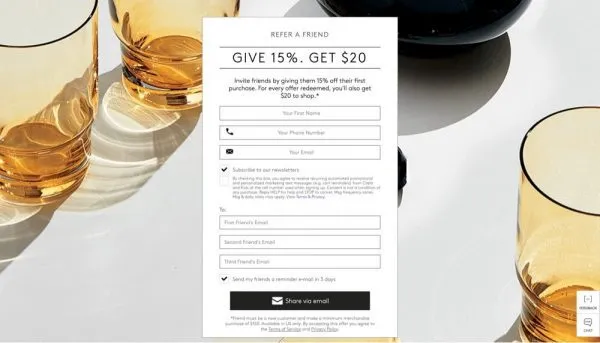
Do you think your store will benefit from a referral program? If yes, then great! However, keep in mind you can’t just launch a referral program and expect instant results, so let’s talk about how you can make it successful.
Every new marketing strategy needs a goal. Begin planning your referral marketing program by clearly stating that goal.
Keep in mind your goal should be SMART: Specific, measurable, achievable, relevant, and time-bound. An example might be to acquire 100 new customers through referrals in the first quarter of the year.
If you need more guidelines on setting up your referral program for the first time, check out these articles first:
You should already have an idea of who your customers are for your other marketing efforts, but referral marketing is an entirely different game. That means not every customer in your purchase history is going to be a good fit.
First, review your current customer list and analytics. Identify a key set of metrics and behaviors you believe suits your ideal referral customer best, and use that to segment a group of shoppers to promote your program. These metrics and behaviors will differ from brand to brand.
To get started, here’s a good article on how to define a target market.
Referral platforms are helpful for smaller teams that can’t invest 100% of their time into managing the program. When choosing a partner to work with, look for software that offers the following:
Ecommerce Tech has a great breakdown of referral marketing apps you can trust to help you choose.
The easier your program is to discover, the more people will convert to become active program members. Make it discoverable on your website by creating a landing page and linking to it in your footer.
There also shouldn’t be barriers for customers to sign in and navigate their referral account—doing so will only discourage people from engaging with it.
Clearly, allowing customers to share their referral code easily is key. MeUndies does this well by allowing referral program members to share their code via email or text right from their account page (i.e. they don’t even have to leave the website to share it).
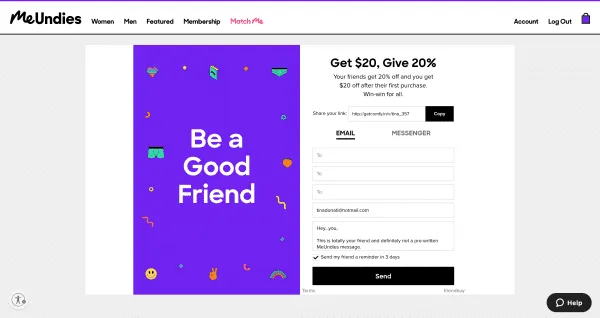
Your referral program should be valuable for both the referrer and referred friend—and take it one step further than just a one-time discount. For example, Derric Haynie, who used to work at BoxyCharm, shared his strategy:
“We implemented what we called the ‘double referral program.’ The double referral strategy means you're going to get an extra product in your next shipment, and the person you're referring to is going to get it in their first shipment too. When both get the product, it's a win-win.”
This strategy generated tens of thousands of referrals without even needing to give a percentage or dollar off.
Once your program launches, track the performance against the goal you set. As your program members begin to refer new customers, you’ll be able to see the effectiveness of your offer and how customers are adopting the program.
After the logistics and launch of your program are under your belt, promoting it will fuel its continued growth and engagement. This part is so key to making sure your program is successful, so I’m going to dedicate an entire section below on that.
There are many different ways brands choose to promote their referral programs, but I’ll include five interesting ideas to consider:
I hope these help you at least get started with driving more engagement toward your referral program. But if you need more resources, here are two great articles to dive into:
Next, let’s see all of what we talked about above get put into action, featuring Verb Energy.

Verb Energy is a healthy snack brand that sells energy bars made with gluten-free, vegan ingredients. The brand was founded just in 2018, yet in a few short years, it has grown a loyal fan base—and even better, a fan base of customers that actively refer friends and family.
But the key to Verb’s success isn’t just having a great product (which they do, by the way). It’s because of the way the Verb team took a unique approach to promote and engage customers in their program.
“Verb's referral program aims to be omnipresent across the entire customer journey by promoting it across all key lifecycle communications: SMS and email.”
—Rebecca Peng, previous Senior Growth Manager at Verb Energy
So how is Verb’s program so successful? I asked Rebecca to share some insight on how the team did it. She explained how Verb switched from the industry standard “10% off” to try something more unique:
“For us, we found success by tapping into the gifting mindset of our customers and were able to see 5x more scale in referrals when we shifted our program from $10 credit for $10 discount off a first purchase (a standard in the industry) to sharing a free Starter Kit with friends.”
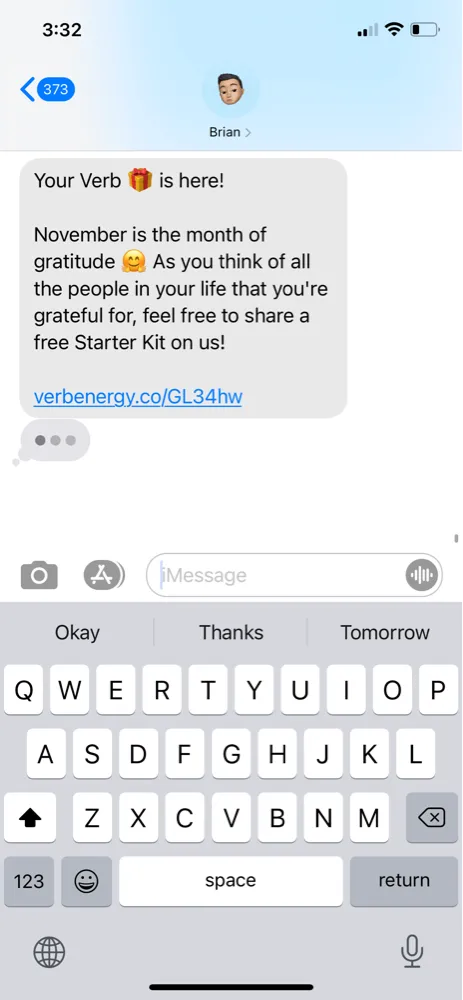
Additionally, in the month of July, Verb ran an appreciation month to subscribers, offering month-long promotions in a secret menu.
The best part? For every purchase made in the month of July, customers got a free Starter Kit to share with a friend. This campaign alone drove more than 15% of the new customers acquired that month (over 2,500 new customers) and brought down Verb’s blended CAC by over $7.
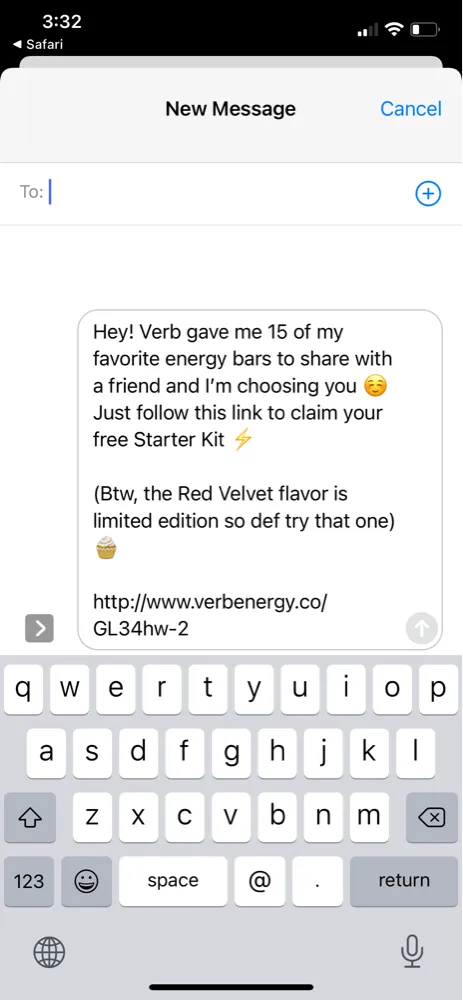
“To craft the best referral program for your customer base, you need to understand what motivates your specific people to share the love of your brand and product. You can't treat your customer base as one homogenous group,” said Rebecca.
Key takeaway: Taking an industry-standard approach is a good place to start, but there are more creative ways to incentivize and engage your customers. Discover what makes your customers react and lean into how your brand can offer something special.
“Segment customers by people who have never referred before (so the messaging should focus on awareness and education of how to refer) and by people who have successfully referred with a focus on further incentivizing.”
—Rebecca Peng, previous Senior Growth Manager at Verb Energy
I know this was a lot of information I just shared with you, but the benefits of referral marketing are clear. And thankfully, brands in almost any industry can do well with a referral marketing program, building up the brand’s credibility, community, and customer base consistently.
Remember, a good referral strategy doesn’t mean launching a program and assuming it’ll work on its own. It requires deep planning, a proper launch, and additional promotional effort.
But when done well, it works.
Your current customers are your biggest brand advocates. In a post-iOS14 world where traditional paid media channels are increasingly more expensive, leveraging the power of word of mouth is increasingly more crucial to driving down overall blended CAC.
Tina Donati is writer, storyteller, and ecommerce enthusiast. With over five years of writing experience, she currently works full time as the content marketing lead at Alloy Automation, while running a freelance writing business with clients in the ecommerce B2B SaaS and agency niche. Living and breathing content 24/7, Tina has worked with clients across the globe. She holds a Master’s degree in journalism and communications, which has helped her combine advanced storytelling and investigative journalism techniques to hunt down credible sources for her writing. Passions aside from writing? Geeking out over SEO, walking her dogs, and hunting for the best burrito.
Grow your sales at a ridiculously
lower CAC.